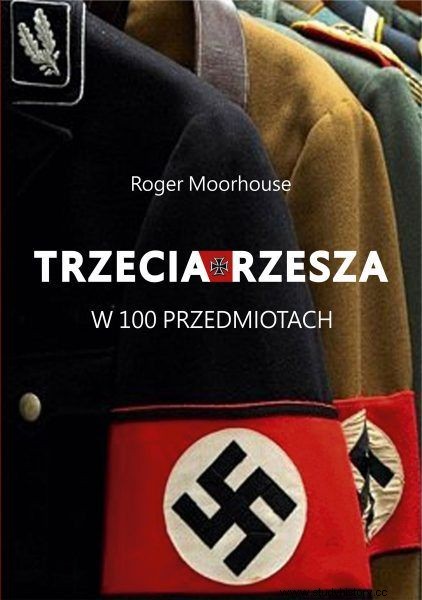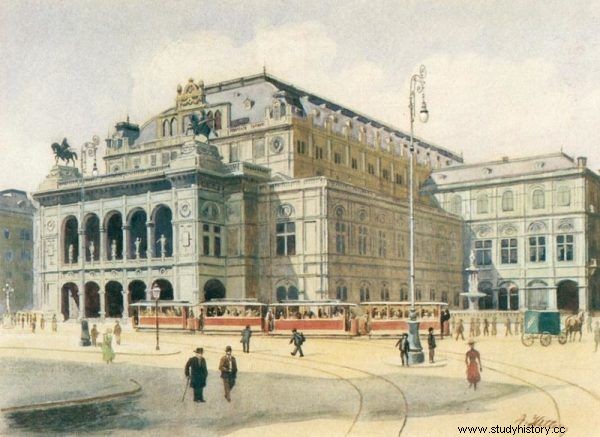If you believe the version presented in Mein Kampf, Adolf Hitler decided to become an artist at the age of 12. Pampered by his adoring widowed mother, he was sure he would become a famous painter in the future.
In 1905, he left school to pursue his dreams. Two years later he went to Vienna to enroll at the local Academy of Fine Arts. With a portfolio of his drawings, he was sure, as he later wrote, that he would "pass the exams with ease".
Dreams of fame
Though his work is often ridiculed, Hitler was certainly a skillful artist. Even before leaving for Vienna, he rarely parted with his sketchbook and kept drawing in it parts of buildings he liked, or sets for the operas he intended to write. As his childhood friend August Kubizek remembers:
In this way, for a long time he treated the bench standing on the "health path" in Linz as a kind of study room, which he used in fine weather. He read his books there, drew and painted watercolors (…).
So when Hitler left Linz to live in Vienna, was convinced that his application to study at the academy would be successful . As he recalled, he was "by far the best student" in school drawing lessons and later made "more than average progress".

Hitler rarely painted people, which was one of the main reasons he was not admitted to the Academy of Fine Arts. From figures such as Mary with Jesus in this painting, he preferred to capture architectural details.
But disappointment awaited him. Although he qualified for the relevant exams, the evaluators found his drawings "unsatisfactory". In the justification, they concisely stated that there were "too few heads" on the presented works.
The bottom line is keep going
Despite his disappointment, Hitler persistently pursued his dreams and after a year he applied again to the academy. This time, however, he was not even allowed to take the exams. This rejection hurt for the rest of his life.
In the following years, the would-be student at the Academy of Fine Arts struggled to make ends meet as an artist, selling pictures and postcards, first in Vienna and then in Munich. During this period, he painted - as he himself claimed - from 700 to 800 works, and he earned about 5 marks per piece . His style was unpretentious, simple and realistic, with mostly buildings, flowers and landscapes as his themes.
"I paint what people want," he once said. He was fascinated by detail, especially architectural, but he placed very few human figures in his works, which reminds us of his earlier failure.

The article is an excerpt from Roger Moorhouse's book "The Third Reich in 100 Objects", published by the Znak Horyzont publishing house.
After the outbreak of the war in 1914, Hitler took watercolors with him to the Western Front, where he painted and sketched the surroundings. His works from this period include a watercolor from December 1914 depicting the monastery in Messines south of Ypres destroyed by artillery fire. It is not known whether the future dictator still dreamed of becoming an artist or just developing his hobby, but it is worth noting that he spent his first pass in Berlin, where he visited the local galleries.
Tyrant with an artistic soul
Though he was still thinking about resuming his studies at the Academy of Fine Arts, politics soon took over his life. At that time, his artistic activity was limited to a few scribbles and small drawings. Among them, the architectural sketches that are part of the Germania Plan, according to which Berlin was intended to be rebuilt, are of particular importance.
Moreover, the Führer's taste determined the character of the culture of the Third Reich. He rejected Goebbels's love of modern art and decided that the official style of Nazi Germany would be boring classicism with bland and sentimental representations of ideal Aryan families.

The future dictator was best at painting buildings such as the Vienna State Opera.
The dictator patronized traditional artists such as the neoclassical sculptor Arno Breker, while more avant-garde artists who enjoyed success during the Weimar Republic, such as designers associated with the Bauhaus, had to emigrate.
The works of Hitler himself were hidden, and obedient merchants were sent across the country, whose task was to obtain those paintings and drawings of the dictator that could be found. Only a few of them were ever published, and they were banned from public display in 1937.
In the later years of the twentieth century, they became sought after by collectors, and some of them reached prices in excess of EUR 100,000 at auctions. The Führer's watercolor box was sold in 2010 for a modest sum of 8,000 euros.
Hitler claimed that his failure to join the Viennese academy only toughened him up for the future but the memory still bothered him. More importantly, it was a turning point in his life. Dreams about an artist's career then faded away, and frustration with the surrounding reality began to grow. Of course, it cannot be said for sure, but it is possible that that failure contributed to the disaster that befell Germany later.
Source:
The above text originally appeared in Roger Moorhouse's book The Third Reich in 100 Objects , which was published by Znak Horyzont.
The title, illustrations with captions, boldface text, explanations in square brackets and subheadings come from the editors. The text has undergone some basic editing to introduce more frequent paragraph breaks.
